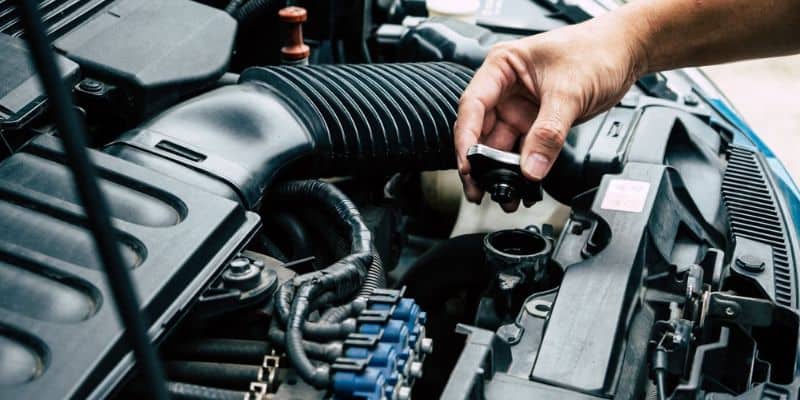Having your coolant levels mysteriously drop and then return can be bewildering. However, there are usually rational scientific explanations for this unusual cooling system behavior.
Let’s take a closer look at some common reasons why coolant disappears then reappears. Additionally, we will guide you through all the precautions to overcome the coolant disappearing issue.
6 Causes of Coolant disappear then reappear
These are six possible reasons for coolant disappearing and then reappearing. It can be a single cause or multiple reasons.
1. Evaporation Through Normal Pressure Release
One possibility is simple evaporation occurring naturally as designed. The radiator cap pressurizes the cooling system when hot to elevate the coolant’s boiling point. Periodically, excess pressure needs venting to maintain a safe maximum level.
As this happens, a small amount of coolant flashes to vapor and escapes. Over time, multiple short episodes of this can deplete levels without notice.
Then when pressure drops during engine off periods, avoided air is replenished by surrounding atmospheric vapor condensing back in.
2. Slight Leak That Self-Seals
Minor external cooling system leaks can sometimes go unnoticed because only a little fluid is lost each time.
Then if driving is delayed until the engine cools fully, the vacuum created may pull small amounts of evaporated residue back to reseal temporarily.
These types of small intermittent leaks are hard to pinpoint visually. However, over many instances of appearing and disappearing fluid loss, leak sources like loose clamps, cracks, and pinholes will commonly reoccur in the same problem areas.
3. Blown Head Gasket or Cylinder Head
Failing head gaskets allowing combustion gasses into the jackets represent a more serious issue.
On initial occurrence, strong differing pressures may cause a surge of coolant to disappear into the cylinders or exhaust.
However, as the engine heats up again the metals may distort differently, closing off the pathway.
This would allow levels to build back up until additional heat cycling resumes leakage on the subsequent cooldown/warmup cycle.
4. Air Pockets and Trapped Bubbles
Entrapped air is another frequent culprit. When hot, the air compresses inside coolant pockets. Then upon cooling contraction, it temporarily displaced liquid until pressure equalizes and fluid flows back in to fill the void.
Persistent airlock issues may necessitate additional bleeding procedures to fully purge all pockets through overflow tube openings and reservoir vent ports.
But occasional brief vanish-and-returns could stem from isolated tiny bubble movements.
5. Overheating Damage
In extreme cases where an engine has endured heat stress close to or into the danger zone, warping around water jackets, heads, and manifolds can occur.
This malformation could cause temporary blockages that intermittently pinch off coolant passageways until heat expansion reopens flow.
Comprehensive testing helps determine if localized thermal damage necessitates costly component replacement before serious cracks or failures emerge over prolonged use.
6. Low Fluid/Incorrect Coolant Type
Running low on coolant means less volume is available to displace into overflow reservoirs during warm-ups.
Marginal amounts may briefly vacate into air pockets till pressures equalize on subsequent cool-downs.
Using coolant not formulated for the system’s metals can also lead to deposits clogging areas intermittently based on temperature fluctuations.
Coolant flushes may be needed to restore proper fluid dynamics.
Preventing Recurring Disappearances
A few proactive maintenance practices can stop coolant from periodically vanishing:
- Inspect all hoses and clamps for cracks, splits, or leaks that may self-seal when cool
- Replace old radiator caps that no longer hold pressure precisely
- Check for air bubbles with the radiator tap and bleed antifreeze lines and reservoir
- Top off coolant levels every oil change to account for minor boil-off loss
- Consider ultrasonic leak testing of engines with head gasket concerns
- Flush systems contaminated by incorrect coolant or use of tap water originally
- Have cooling systems pressure tested if overheating incidents occurred
Catching intermittent issues early forestalls major repairs down the road. Consistent fluid levels and no overheating signs ensure a dilution is functioning as intended long-term.
FAQs
What should coolant levels be maintained at?
The reservoir/expansion tank should be filled to the COLD fill line indicated. This leaves space for thermal expansion when hot without any overflow.
How often do I need to change the coolant?
Most manufacturers recommend changing it every 5 years or 100k miles as preventative fluid maintenance. Contaminated or old coolant loses effectiveness.
When should the radiator be flushed?
Flushes remove buildup that can clog passages. Have it done if overheating occurs, the coolant is dirty/rusty, or as part of radiator replacement to clean the whole system.
Conclusion
Hopefully looking at the common reasons behind intermittent coolant loss has offered some reassurance the issue may not signal catastrophic failures in all cases.
Seeking a mechanic’s diagnosis when reoccurring is prudent to catch emerging problems sooner. Adopting good care practices like consistent fluid level checks and timely component maintenance helps maximize the long-term dependability of your vehicle’s cooling system.

Hi, Michael Williams here. I have always loved everything with an engine. After earning my degree in automotive engineering, I spent 5 years testing vehicles for a major manufacturer in Illinois. Now I am using my technical skills to review the latest models online and help others troubleshoot their engine problems with effective solutions.
